Boeing (McDonnell Douglas) JDAM
(GBU-29/B, GBU-30/B, GBU-31/B, GBU-32/B,
GBU-34/B, GBU-35/B, GBU-38/B, GBU-54/B, GBU-55/B, GBU-56/B,
GBU-61/B, GBU-62/B, GBU-64/B, GBU-72/B)
History and General Description
In late 1991, the U.S. Air Force and U.S. Navy formulated common requirements for a new class of low-cost general-purpose precision guided bombs. The program was initially labeled AWPGM (Adverse Weather Precision Guided Munition), but was eventually named JDAM (Joint Direct Attack Munition). After the USAF had successfully demonstrated a GPS-aided inertial (a.k.a. GPS/INS) guidance package in 1993, the goal for JDAM became the development of a low-cost GPS/INS add-on guidance kit for existing 1000 lb and 2000 lb class "dumb" bombs. In April 1994, development contracts were let to McDonnell Douglas and Martin Marietta. After wind-tunnel tests of both designs, McDonnell Douglas was selected in October 1995 as prime contractor for further development of JDAM.
JDAM flight testing began in 1996, and the first LRIP (Low Rate Initial Production) contract was awarded in April 1997. In December 1998, JDAM officially reached IOC (Initial Operational Capability) on the first platform, the USAF's B-52H. Other aircraft soon followed, and today all U.S. bombers and strike aircraft can carry JDAM weapons.
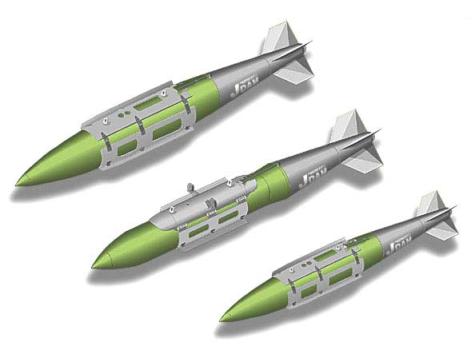 |
| Image: USAF |
| JDAM warheads (From top: MK 84, BLU-109/B, MK 83) |
JDAM add-on kits exist for a variety of bombs, including the 2000 lb MK 84, BLU-109/B and BLU-117/B, the 1000 lb MK 83 and BLU-110/B, and the 500 lb MK 82 and BLU-111/B (for a detailed rundown of all versions, see Variants section below). The main part of a JDAM add-on kit is the guidance and control section, which is mounted at the tail of the bomb body. This section houses the INS unit, the GPS receiver, the control electronics, and cruciform tailfins (three moving, one fixed) to steer the bomb. Additionally, strakes are fitted to the bomb body to enhance its stability and gliding capability. The strakes are mounted to the bomb's center body, except for the 500 lb class bombs (MK 82, BLU-111/B), where the strakes are on the nose because of bomb rack mounting requirements. Using full GPS-aided INS guidance, the accuracy of JDAM is officially quoted as 13 m (43 ft), but real figures are reportedly slightly better, around 10 m (33 ft). When GPS is unavailable (e.g. because of jamming), accuracy in INS-only mode drops to 30 m (100 ft) CEP, but that's still good enough for many purposes, and therefore GPS-jamming is far from disabling JDAM bombs. From typical operating altitudes, the stand-off range of a JDAM is around 8-24 km (5-15 miles). At any time in the mission, the delivery aircraft's pilot is informed if he is within the valid drop envelope for the desired target coordinates.
2.jpg) |
| Photo: Cpl. Paul Leicht, U.S. Marine Corps |
| GBU-31(V)2/B (subvariant unknown) |
At the time of this writing, several tens of thousands of JDAM kits of all versions have already been built, and full-scale production is continuing. The total production run may eventually reach up to 250000 units. JDAM precision guided bombs have effectively replaced "dumb" bombs as the standard general-purpose air-to-ground weapon of the USAF and U.S. Navy. In operations over Iraq in 2003, the majority of dropped munitions were guided JDAM bombs.
Laser JDAM
JDAM's big advantage over modern Paveway III laser-guided bombs is that JDAM operation is inherently simpler. It is all-weather capable, because you don't need to laser-designate the target, and it's a true fire-and-forget weapon. However, it is slightly less accurate than LGBs, and can't be used on moving targets. Efforts to supply JDAM with a terminal seeker to work around these shortcomings included DAMASK (Direct Attack Munitions Affordable Seeker), which demonstrated between 1997 and 1999 an IIR (Imaging Infrared) seeker and associated control algorithms to improve CEP to 3 m (10 ft).
Until 2006, no terminal seeker had been adopted as a standard option for JDAM, possibly because the availability of GPS/INS-enhanced Paveway II and Paveway III laser-guided bombs made such a capability less urgent. But in June 2007, Boeing received a first production contract for 600 laser seeker add-on kits (400 Air Force, 200 Navy) for JDAM. JDAM rounds fitted with such a seeker are known as LJDAM (Laser JDAM), and add the capability to attack moving targets to the weapon.
Variants
GBU-29/B, GBU-30/B
The designations GBU-29/B and GBU-30/B were reserved for 2000 lb (GBU-29) and 1000 lb (GBU-30) class JDAM bombs
with guidance kits from Martin Marietta. Because Martin Marietta lost the JDAM competition, no GBU-29 and -30 bombs
were produced.
Note: Reports, that GBU numbers -29 and -30 referred to projected 250 lb and 500 lb class JDAMs,
respectively, are erroneous.
GBU-31/B
The designation GBU-31/B was allocated early in the JDAM program to 2000 lb class JDAM bombs with guidance kits from McDonnell Douglas (now part of Boeing). Current production JDAMs with 2000 lb class warheads are designated in the GBU-31(V)/B series. At least four different types of warhead can be used with the 2000 lb JDAM tailkits:
- MK 84: Standard 2000 lb LDGP (Low-Drag General Purpose) bomb
- BLU-109/B: 2000 lb class penetrator warhead
- BLU-117A/B: Instead of the MK 84, the Navy can also use the BLU-117A/B warhead in their GBU-31(V)2/B series JDAMs. The BLU-117A/B is externally identical to the MK 84, but uses the PBXN-109 thermally insensitive explosive.
- BLU-119/B: Crash PAD (Prompt Agent Defeat) weapon, a blast/fragmentation warhead to damage fixed biological/chemical targets without contaminating the area; external shape identical to MK 84
It can be assumed that other 2000 lb warheads, which use MK 84 or BLU-109 casings, can also be fitted with GBU-31 series JDAM guidance kits. This includes e.g. the BLU-118/B and BLU-121/B thermobaric bombs.
3.jpg) |
| Photo: USAF |
| GBU-31(V)3/B (subvariant unknown) |
Known designations of GBU-31(V)/B variants include:
| Designation | Warhead | Guidance Kit 1 | User |
|---|---|---|---|
| GBU-31(V)1/B 2 GBU-31A(V)1/B | MK 84 2 | KMU-556/B KMU-556A/B |
U.S. Air Force |
| GBU-31B(V)1/B | KMU-556B/B | ||
| GBU-31C(V)1/B | KMU-556C/B | ||
| GBU-31(V)2/B 2 GBU-31A(V)2/B | MK 84 3 or BLU-117A/B | KMU-556/B KMU-556A/B |
U.S. Navy |
| GBU-31B(V)2/B | KMU-556B/B | ||
| GBU-31C(V)2/B | KMU-556C/B | ||
| GBU-31(V)3/B 2 GBU-31A(V)3/B | BLU-109/B | KMU-557/B KMU-557A/B |
U.S. Air Force |
| GBU-31B(V)3/B | KMU-557B/B | ||
| GBU-31C(V)3/B | KMU-557C/B | ||
| GBU-31(V)4/B 2 GBU-31A(V)4/B | BLU-109A/B 4 | KMU-558/B KMU-558A/B |
U.S. Navy |
| GBU-31B(V)4/B | KMU-558B/B | ||
| GBU-31C(V)4/B | KMU-558C/B | ||
| GBU-31(V)5/B | BLU-119/B | KMU-???/B 5 | U.S. Air Force |
Notes:
- The initial KMU-55x/B guidance kits used fin actuators with "Friction Brake" technology. Beginning in 2000, this was replaced by a "Pin-Lock" actuator system, which is more durable and accurate. Guidance kits with pin-lock actuators are designated KMU-55xA/B. Improvements to the GPS unit of the KMU-55xA/B led to the KMU-55xB/B kits, which have a GPS receiver with a so-called SAASM (Selective Availability/Anti-Spoofing Module), and the KMU-55xC/B kits, which are equipped with SAASM/AJ (SAASM/Anti-Jam) GPS receivers.
- The "A" suffixes in the designations were cancelled in 2006, and GBU-31( )(V)/B variants with non-GPS-improved KMUs are now all designated as GBU-31(V)/B.
- The visible difference between the USAF's GBU-31(V)1/B and the Navy's GBU-31(V)2/B is that the latter's MK 84 and BLU-117A/B bombs are coated with a thermal protection layer. This gives the bombs a wrinkled grey external finish, opposed to the USAF's smooth olive drab bomb bodies.
- The BLU-109A/B is a thermally protected variant of the BLU-109/B.
- The GBU-31(V)5/B almost certainly uses guidance kits of the KMU-556( )/B series.
4.jpg) |
| Photo: U.S. Navy |
| GBU-31(V)4/B (subvariant unknown) |
GBU-32/B, GBU-35/B
The designation GBU-32/B was allocated early in the JDAM program to 1000 lb class JDAM bombs with guidance kits from McDonnell Douglas (now part of Boeing). Current production JDAMs with 1000 lb class warheads are designated in the GBU-32(V)/B (and formerly also GBU-35(V)/B) series. At least two different types of warhead can be used with the 1000 lb JDAM tailkits:
- MK 83: Standard 1000 lb LDGP (Low-Drag General Purpose) bomb
- BLU-110/B: Instead of the MK 83, the Navy can also use the BLU-110/B warhead in their GBU-32(V)2/B series JDAMs. The BLU-110/B is externally identical to the MK 83, but uses the PBXN-109 thermally insensitive explosive. The BLU-110A/B and -110C/B variants, which are the ones that are actually used by the Navy (indicated by "BLU-110( )/B" in the table below), have external protective coating.
Known designations of GBU-32(V)/B and GBU-35(V)/B variants include:
| Designation | Warhead | Guidance Kit 1 | User |
|---|---|---|---|
| GBU-32(V)1/B 2 GBU-32A(V)1/B | MK 83 3 | KMU-559/B KMU-559A/B |
U.S. Air Force |
| GBU-32B(V)1/B | KMU-559B/B | ||
| GBU-32C(V)1/B | KMU-559C/B | ||
| GBU-32(V)2/B 2 GBU-32A(V)2/B | MK 83 3 or BLU-110( )/B | KMU-559/B KMU-559A/B | U.S. Navy |
| GBU-32B(V)2/B | KMU-559B/B | ||
| GBU-32C(V)2/B | KMU-559C/B | ||
| GBU-35(V)1/B 4 | BLU-110( )/B | KMU-559( )/B | U.S. Navy |
Notes:
- The initial KMU-559/B guidance kits were to use fin actuators with "Friction Brake" technology, but these kits were never put into production. Beginning in 2000, the "Frictiob Brake" system was replaced by a "Pin-Lock" actuator system, which is more durable and accurate. Guidance kits with pin-lock actuators are designated KMU-559A/B. Improvements to the GPS unit of the KMU-559A/B led to the KMU-559B/B kits, which have a GPS receiver with a so-called SAASM (Selective Availability/Anti-Spoofing Module), and the KMU-559C/B kits, which are equipped with SAASM/AJ (SAASM/Anti-Jam) GPS receivers.
- Because the original KMU-559/B kits were never produced, the plain GBU-32(V)1/B and (V)2/B designations initially never applied to stockpiled bombs. However, the "A" suffixes in the designations were cancelled in 2006, and GBU-32( )(V)/B variants with non-GPS-improved KMUs are now designated as GBU-32(V)/B.
- The visible difference between the USAF's GBU-32(V)1/B and the Navy's GBU-32(V)2/B is that the latter's MK 83, BLU-110A/B and -110C/B bombs are coated with a thermal protection layer. This gives the bombs a wrinkled grey external finish, opposed to the USAF's smooth olive drab bomb bodies.
- The U.S. Navy has abandoned the GBU-35(V)1/B nomenclature, and is now referring to all its 1000 lb class JDAMs as GBU-32(V)2/B, regardless of warhead. This is in line with nomenclature usage for 2000 lb (GBU-31(V)/B) and 500 lb (GBU-38/B) JDAMs.
GBU-34/B
The GBU-34/B, built by Lockheed Martin, is a JDAM with a BLU-116/B penetrating warhead. The 2000 lb class BLU-116/B AUP (Advanced Unitary Penetrator) warhead is primarily used in the GBU-24/B series of 2000 lb Paveway III LGBs, but has also been evaluated for use as a JDAM munition. However, the GBU-34/B apparently never entered operational stockpiles.
GBU-38/B
The designation GBU-38(V)/B was allocated to 500 lb class JDAM bombs with guidance kits from Boeing. At least two different types of warhead can be used with the 500 lb JDAM tailkits:
- MK 82: Standard 500 lb LDGP (Low-Drag General Purpose) bomb
- BLU-111/B: Instead of the MK 82, the BLU-111/B warhead can also be used in the GBU-38/B series JDAMs. The BLU-111/B is externally identical to the MK 82, but uses the PBXN-109 thermally insensitive explosive. The BLU-111A/B and -111C/B variants, used by the Navy, have external protective coating.
- BLU-126/B: The BLU-126/B LCDB (Low Collateral Damage Bomb) is externally identical to the BLU-111/B, but is filled with less explosives for a reduced fragmentation pattern blast radius. The LCDB was developed by the U.S. Navy for use in situations where friendly forces and/or civilians are close to the target
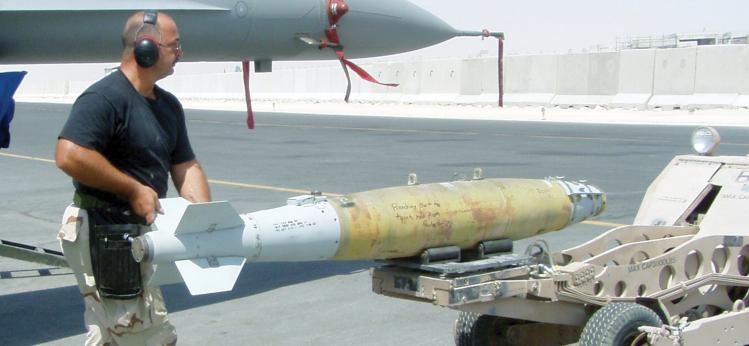 |
| Photo: Capt. Mae-Li Allison, USAF |
| GBU-38(V)1/B (exact subvariant unknown) |
Known designations of GBU-38(V)/B variants include:
| Designation | Warhead | Guidance Kit 1 | User |
|---|---|---|---|
| GBU-38(V)1/B 2 GBU-38A(V)1/B | MK 82 3 or BLU-111/B | KMU-572/B KMU-572A/B |
U.S. Air Force |
| GBU-38B(V)1/B | KMU-572B/B | ||
| GBU-38C(V)1/B | KMU-572C/B | ||
| GBU-38(V)2/B 2 GBU-38A(V)2/B | MK 82 3 or BLU-111( )/B | KMU-572/B KMU-572A/B |
U.S. Navy |
| GBU-38B(V)2/B | KMU-572B/B | ||
| GBU-38C(V)2/B | KMU-572C/B | ||
| GBU-38(V)3/B 2 GBU-38A(V)3/B | BLU-126/B 3 | KMU-572/B KMU-572A/B |
U.S. Air Force |
| GBU-38B(V)3/B | KMU-572B/B | ||
| GBU-38C(V)3/B | KMU-572C/B | ||
| GBU-38(V)4/B 2 GBU-38A(V)4/B | BLU-126/B 3 | KMU-572/B KMU-572A/B |
U.S. Navy |
| GBU-38B(V)4/B | KMU-572B/B | ||
| GBU-38C(V)4/B | KMU-572C/B |
Notes:
- There was never a KMU-572/B guidance kit. The first variant of the KMU-572 kit already had the pin-lock fin actuators, and therefore designations with an "A" suffix were assigned to follow the nomenclature pattern of the 2000 lb and 1000 lb JDAMs. Improvements to the GPS unit of the KMU-572A/B led to the KMU-572B/B kits, which have a GPS receiver with a so-called SAASM (Selective Availability/Anti-Spoofing Module), and the KMU-572C/B kits, which are equipped with SAASM/AJ (SAASM/Anti-Jam) GPS receivers.
- Because the original KMU-572/B kits were never produced, the plain GBU-38(V)1/B and (V)2/B designations were initially never applied to any bombs. However, the "A" suffixes in the designations were cancelled in 2007, and GBU-38( )(V)/B variants with non-GPS-improved KMUs are now designated as GBU-38(V)/B.
- The visible difference between the USAF's and the Navy's GBU-38(V)/B series is that the latter's MK 82, BLU-111( )/B and BLU-126/B bombs are coated with a thermal protection layer. This gives the bombs a wrinkled grey external finish, opposed to the USAF's smooth olive drab bomb bodies.
GBU-54/B
The GBU-54(V)/B series is the Laser JDAM variant of the GBU-38(V)/B 500 lb class JDAM. It consists of a GBU-38(V)/B bomb fitted with a DSU-38/B laser homing target detection device. Variant designations for the GBU-54(V)/B and -38(V)/B series correspond to each other, e.g. a GBU-54x(V)n/B is a GBU-38x(V)n/B with a DSU-38/B laser seeker. Accordingly, the following GBU-54 variants exist: GBU-54(V)1/B, GBU-54B(V)1/B, GBU-54C(V)1/B, GBU-54(V)2/B, GBU-54B(V)2/B, GBU-54C(V)2/B, GBU-54(V)3/B, GBU-54B(V)3/B, GBU-54C(V)3/B, GBU-54(V)4/B, GBU-54B(V)4/B and GBU-54C(V)4/B.
GBU-55/B, GBU-56/B
The designations GBU-55(V)/B and GBU-56(V)/B have been reserved for the Laser JDAM variants of the GBU-32(V)/B 1000 lb class and GBU-31(V)/B 2000 lb class JDAMs, respectively. However, at the time of this writing there are no customers for these LJDAM versions.
GBU-61/B CMS
The GBU-61/B CMS (Countermine System) is a specialized JDAM munition to neutralize mine fields. The body, which has the same form factor and mass as the BLU-109/B, is fitted with a KMU-556/B guidance kit. It contains several thousand small (length about 15 cm) tungsten-tipped darts, which are released at high speed to penetrate the ground and the mines' casings. The mines are neutralized by either detonatating them, destroying the fuzing mechanism, or chemically inactivating the explosive filling.
GBU-72/B A5K
The GBU-72/B Advanced 5000 lb (A5K) penetrator is a 2300 kg (5000 lb) class BLU-138/B penetrator warhead fitted with a JDAM guidance kit and tail assembly. The first drop tests occurred in 2021, and the GBU-72/B is planned to replace the GBU-28/B Paveway III penetrator bombs.
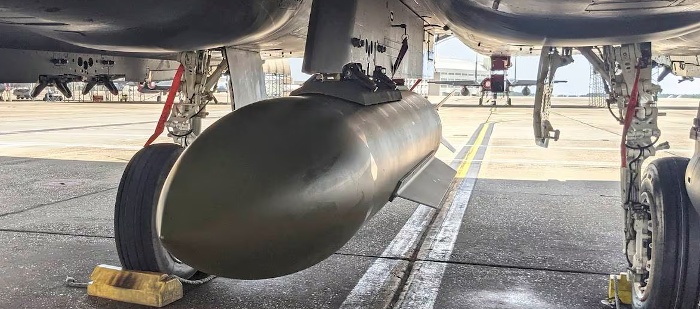 |
| Photo: USAF |
| GBU-72/B |
JDAM-ER
In the 2006/2008 time frame, Boeing and the Australian DSTO (Defence Science and Technology Organisation) jointly developed and tested a wing-kit for 500 lb class JDAM weapons (GBU-38/B). The resulting glide bomb, labeled JDAM-ER (JDAM Extended Range), triples the range of JDAM, reaching up to 80 km (50 miles) when launched from high altitude. The 500 lb JDAM-ER entered service with the Royal Australian Air Force in 2016. In a similar effort, Boeing and the South Korean company Times Aerospace Korea (TAK) developed a JDAM-ER wing-kit for 2000 lb class JDAM weapons (GBU-31/B).
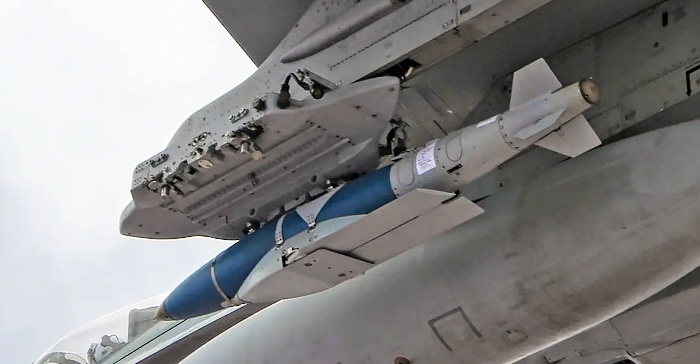 |
| Photo: Australian Defense Force |
| 500 lb JDAM-ER |
GBU-62/B, GBU-64/B
The only confirmed U.S. military application of JDAM-ER is the use of these wing-kits with mines of the Quickstrike family. The designations GBU-62(V)1/B and GBU-64(V)1/B refer to 500 lb class MK 62 and 2000 lb class MK 64 mines with a JDAM-ER kit, respectively. In this configuration, the mines are also known as Quickstrike-ER.
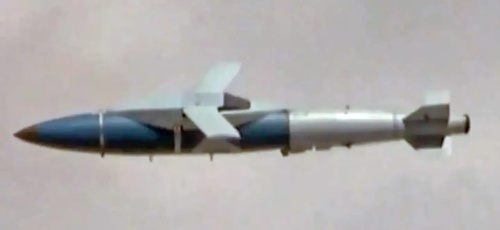 |
| Photo: Royal Australian Air Force |
| 500 lb JDAM-ER |
Designation Note: Other than GBU-62/B and -64/B for Quickstrike-ER, no other GBU designations for JDAM-ER have been mentioned. However, GBU numbers 63, and 65 to 68, are all unaccounted for, and it's not implausible that some of these numbers have been reserved for possible future JDAM-ER applications by the U.S. military.
Specifications
Note: Data given by several sources show slight variations. Figures given below may therefore be inaccurate!
Data for GBU-31(V)2/B, GBU-31(V)4/B, GBU-32(V)2/B, GBU-38(V)1/B:
| GBU-31(V)2/B | GBU-31(V)4/B | GBU-32(V)2/B | GBU-38(V)1/B | |
|---|---|---|---|---|
| Length | 3.879 m (152.72 in) | 3.774 m (148.6 in) | 3.035 m (119.49 in) | 2.353 m (92.64 in) |
| Diameter | 46 cm (18 in) | 37 cm (14.5 in) | 35.6 cm (14 in) | 27.3 cm (10.75 in) |
| Fin span | 64.3 cm (25.32 in) | 49.8 cm (19.62 in) | 43.2 cm (17.0 in) | |
| Weight | 946 kg (2085 lb) | 981 kg (2162 lb) | 468 kg (1031 lb) | 253 kg (558 lb) |
| Warhead | MK 84 bomb or BLU-117/B | BLU-109A/B | MK 83 bomb or BLU-110/B | MK 82 bomb or BLU-111/B |
Main Sources
[1] GlobalSecurity.org Website
[2] U.S. Navy PMA-201 JDAM Specs
[3] USAF nomenclature records for GBU series designations
[4] Wikipedia: Joint Direct Attack Munition
[5] Wikipedia: Countermine System
Back to Directory of U.S. Military Rockets and Missiles, Appendix 5
Last Updated: 4 February 2024